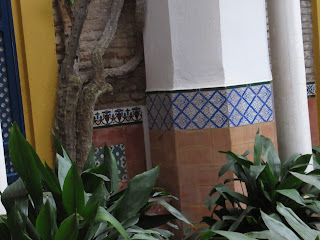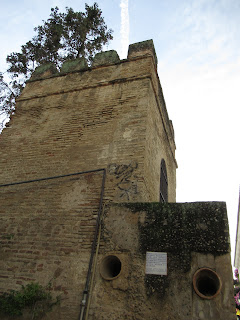I just returned from being away on vacation with a friend in New Zealand and Australia for the last 3.5 weeks. In case you also want to follow that trip, here's a link to the newest blog: www.bergersadventures7.blogspot.com
This post started out as simply photos of street scenes that caught my eye while Steven and I explored Sevilla last December. Later in the post are text and photos associated with a walk we took through the Barrio Santa Cruz. I hope you'll enjoy both parts.
We lost track of all the churches we passed while walking around Sevilla!
The nearby Casa de Murillo had been the home of Murillo who loved to paint “the ambiance of street life and reproducing it in his paintings of cute beggar children.”
This post started out as simply photos of street scenes that caught my eye while Steven and I explored Sevilla last December. Later in the post are text and photos associated with a walk we took through the Barrio Santa Cruz. I hope you'll enjoy both parts.
Sevilla was the first city where we noticed so much graffiti or tagging in about five weeks of our exploring much of Spain.
The tiled picture depicted Nuestra Senora del Carmen or Our Sister of Carmen. It was fun trying to pick out all the tiled images of Mary in Sevilla!
It was sure worth looking up in Sevilla so you wouldn't miss seeing something! I'd have loved to know what the significance of the snail was.
I don't recall seeing so many tiled religious plaques on buildings anywhere before, especially since many of them weren't associated with churches.
Another view of part of the marvelous all wood Metropol Parasol, jokingly referred to as the Seven Mushrooms by Sevillianos!
The city's symbol on buildings and sewers referred to its allegiance to King Alfonso X during the 13th War of Spanish Succession.
An example of the city's exquisite tile work we so admired.
The day before, the far right VOX political party won 12 seats in Andalusian parliamentary elections for the first time since the return to democracy at the end of Francisco Franco's dictatorship. The leader of the party was anti-abortion, anti-migration, and anti-same sex marriage. Part of the rationale for the party's success was Andalusia is the region that received most of the African immigrants with 53,000 arriving in 2018.
I mentioned in my first post on Sevilla that many young girls aspire to be flamenco dancers. Here was one in action that caught our attention but sadly not those of the people walking around her. Perhaps it wasn't a novelty to them as it was to us?
Not a fire, not a riot, thank goodness, but simply smoke wafting from roasting chestnuts, we realized, as we got much closer.
So sweet seeing this little girl so entranced with the many Nativity figures for sale near the Cathedral. I don't think we'd ever seen so many displays before.
La Exposicion Sevillana referred to the city's world fair in 1929.
After being wowed that morning by the immensity and opulence of the world's largest Gothic cathedral, we decided to follow travel writer Rick Steves’ Barrio Santa Cruz walking tour as he described the area as one of the most interesting neighborhoods to walk around in Sevilla to get a good feel for the city. The once-thriving Jewish Quarter was now just where “a tangled street plan and a wistful Old World ambiance survive” according to Steves.
The Banderas Courtyard - named because of its flags and not the actor Antonio! - was once a military parade ground for the royal guard. The king's bodyguards resided in the barracks surrounding the square.
In the far corner was the Juderia Arch that led down a long, dimly lit narrow passageway. It was rather creepy walking along it as we could sense that in days past, the city's Jews were forced to walk these same steps into their own restricted area before thousands were killed in 1391 and thousands more were forced to flee the country.
The walk took us alongside the wall of the Alcazar, a royal palace we'd see the following day.
It was enjoyable strolling along a narrow alleyway called Calle Agua as we could peek through iron gates for occasional glimpses of flower-filled patios of private homes. One of them was ringed with columns and decorated with glazed tiles. They weren’t simply pretty, they kept buildings cooler in the summer heat.
At the end of the lane, we spotted the openings of two old pipes built into the wall. These 12th century Moorish pipes once carried water to the Alcazar and gave the street we’d just walked down its name, Water St.
Through the iron gate was the entrance to the Murillo Gardens that had been named after Sevilla’s famous native painter of the same name. The gardens supplied fruits and vegetables to the Alcazar.
The heart of the barrio was the Plaza de la Santa Cruz which was once the site of one of the four synagogues that had thrived in the barrio. The Christians destroyed each of them and replaced the synagogue in the square with a church that was later demolished by the French under Napoleon. Locals remember that history when they see the over sized French tricolor flag indicating the French Consulate.
The attractive 16th century iron cross marked the center of the square and also the site of the church torn down by the French. Murillo, who was buried in the church, was somewhere under our feet!
The courtyard at the home at #9 had been left intentionally open so people could revel in its beauty.
One of the joys of walking around Sevilla was the beautiful patios that welcomed prying eyes!
The nearby Casa de Murillo had been the home of Murillo who loved to paint “the ambiance of street life and reproducing it in his paintings of cute beggar children.”
Right across from the casa was the Monasterio de San Jose del Carmen where St. Teresa stayed when she visited from Avila, her hometown. The church was unfortunately closed to visitors.
A few streets away was Calle Reinoso, a street that was so narrow that the buildings almost touched that was therefore referred to as one of the barrio’s ‘kissing lanes.’ One explanation suggested the buildings were built cheek by jowl was to provide shade. But Steves wrote that their labyrinthine street plan was more complex and that its history went back to the Moorish era when this area was a busy market. This later became the Jewish ghetto, where all the city’s Jews were forced to live in a very small enclave.
A benefit of the narrow lanes is shade; the locals even claim that the barrio is three degrees cooler than the rest of Sevilla.
The Plaza de los Venerables was another choice for the ‘heart of the barrio’ when, centuries after the Jews were expelled from Spain in 1492, Sevilla turned the square into a showpiece of Andalusian style, adding the railings, orange trees, exquisite tile work and other attractions. The square may not have been ‘authentic’ or true to its historical origins but it was certainly very attractive.
Orange trees had been planted throughout the area because they provided constant shade and they never lose their leaves. There was no incentive to pinch a few, though, because they were known to very bitter and used to make vitamins, perfume and cat food - what a very odd combination! If you’ve ever had orange marmalade found in all British B&Bs, that was made from these oranges, too. Steven and I will be traveling around Ireland and Britain for seven weeks beginning in late August so it’ll be fun seeing the marmalade offered everywhere and know its origins.
The square received its name from the Hospital de los Venerables, built in 1675, which had once been a retirement home for old priests or venerables in Spanish.
A tile map showed the former Jewish Quarter that ceased to exist after Christian mobs ransacked it in 1391, Jews were killed or driven from their homes, an uprising that spread from Sevilla through the rest of Spain and later Europe. Juderia eventually became the neighborhood of the Holy Cross or Barrio Santa Cruz.
A little further along was the Plaza de Dona Elvira with more orange trees, attractive tile benches surrounding the square and a tiled fountain to match. Of course it wouldn't have been complete without shops selling souvenirs and work by local artisans, too!
Just in case we'd not yet seen enough pretty plazas that day, we came across the Plaza de la Alianza a few minutes later. In an house on the square, an American, John Fulton, pursued a painting career after getting hooked on bullfighting and training in Mexican bullrings and then moving to Sevilla, the world capital of the sport. After he laid down his cape as a bullfighter, he followed his second dream: to become a painter.
I couldn't resist taking this shot on our way back to the hotel after a full day sightseeing!
My dear friend, Lina - you get one guess whom I was thinking of when I noticed this flamenco shop with your name on it!
How nice to come 'home' to our hotel and find my nightie so prettily arranged except I was tired after a long day sightseeing and just wanted to jump into it right away!
Next post: The Alcatraz, getting robbed and a flamenco show - i.e. experiencing the highs and lows of Sevilla in one day!
Posted on March 9th, 2019, from Queenstown, NZ, while traveling with a friend.











































































No comments:
Post a Comment